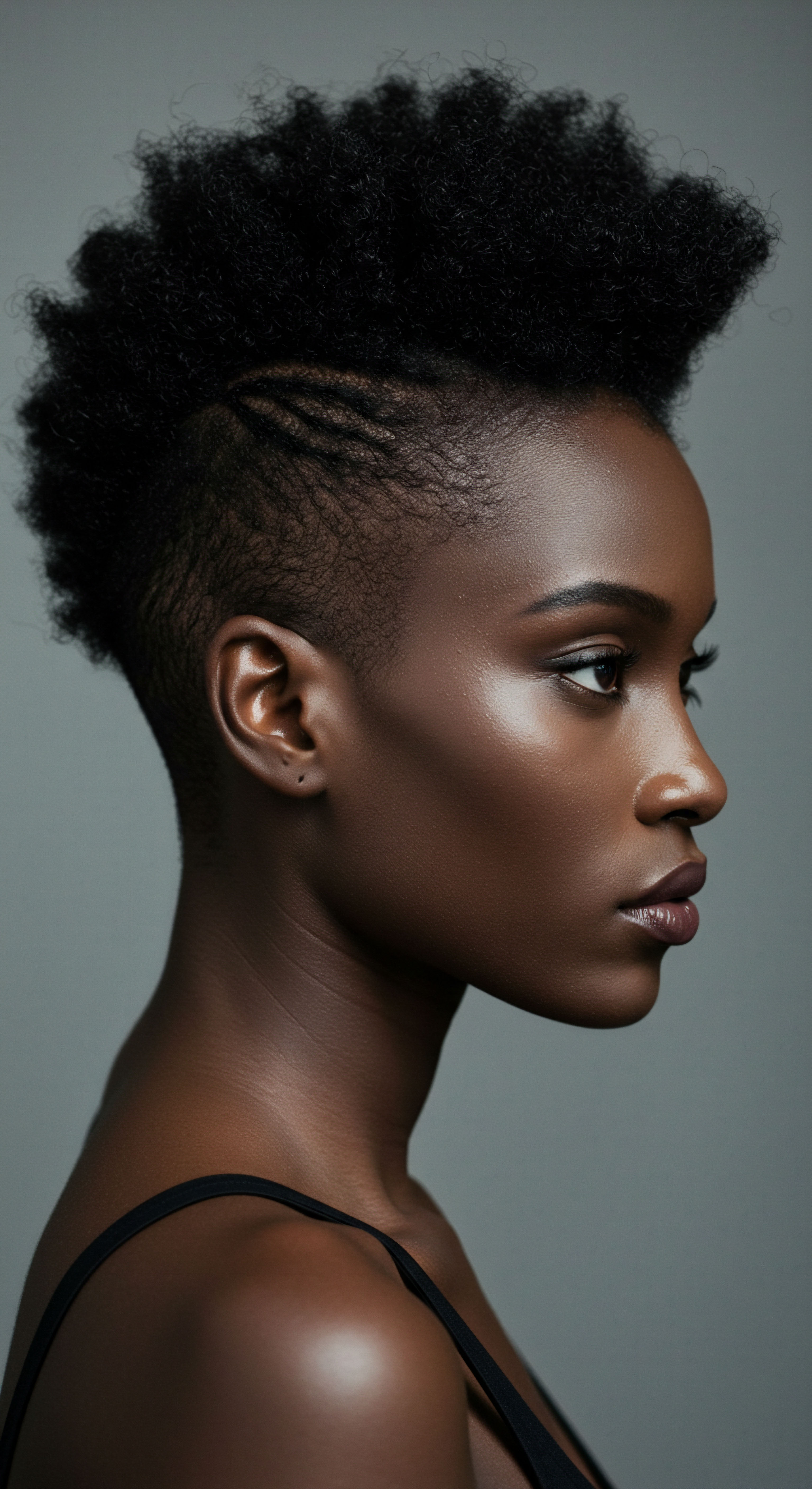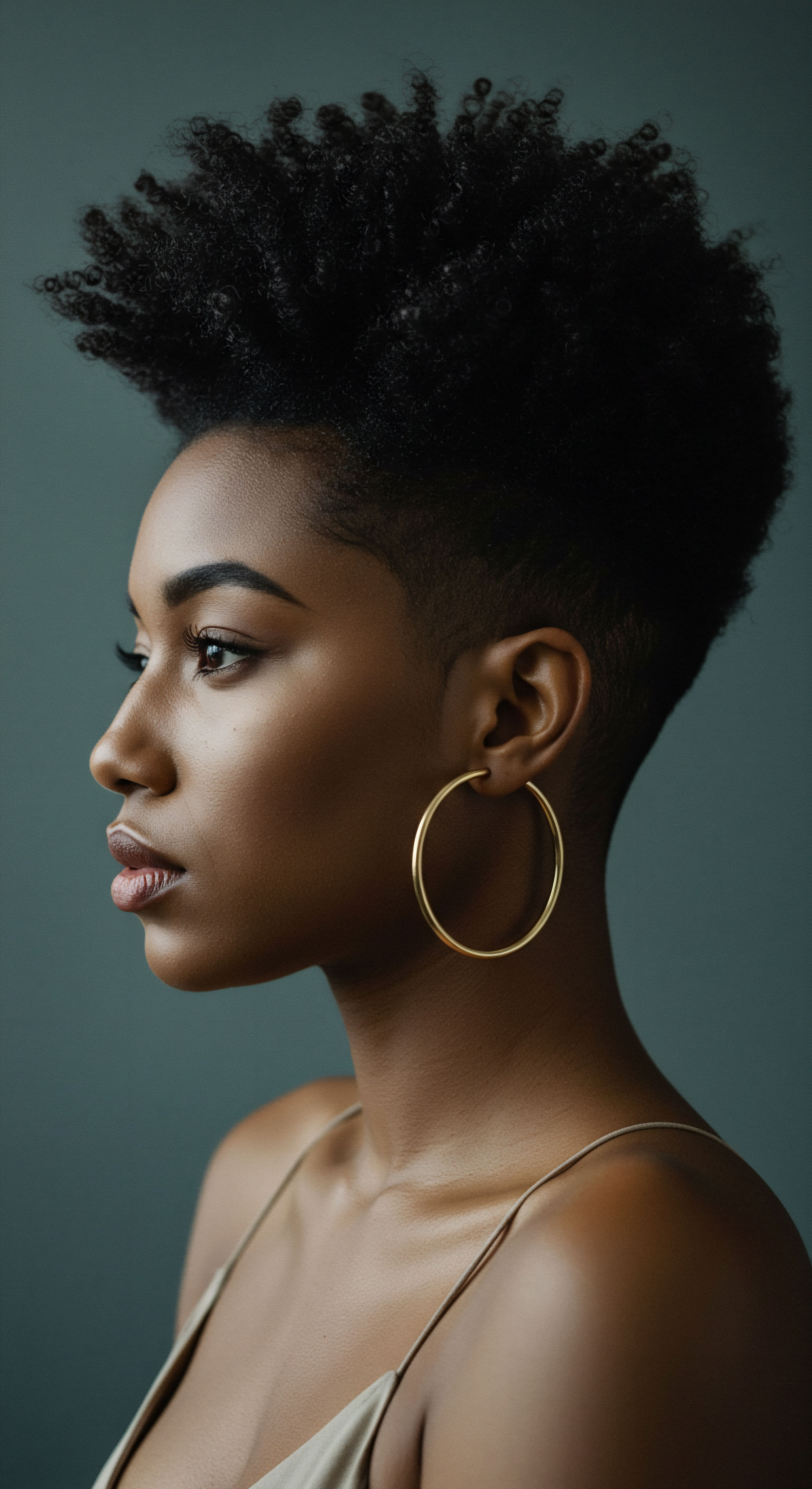
Roots
The whisper of the earth finds its way into our daily routines, sometimes unnoticed, sometimes deeply felt. Consider the quiet unfolding of a leaf, the slow dance of roots reaching for sustenance, or the profound connection between soil and the vibrant life it cradles. Our strands, too, hold a kinship with this elemental world, drawing their very substance from ingredients born of the ground, the sun, and the rain.
When we ponder the influence of our choices on the enduring well-being of hair ingredient sourcing, we are not simply considering commerce; we are exploring a fundamental relationship, a dialogue between human desire and the planet’s finite gifts. It is a subtle conversation, often conducted without words, yet its implications ripple across continents, touching lives and landscapes.

The Earth’s Bounty and Our Hair’s Nourishment
Our hair, particularly textured hair with its unique architecture and thirst for deep conditioning, has historically found solace and strength in the gifts of the natural world. From the rich, creamy goodness of shea butter, traditionally harvested from the karite tree across West Africa, to the liquid gold of argan oil, pressed from the kernels of Moroccan argan trees, these ingredients carry with them not just their chemical composition, but also the stories of the lands and communities from which they come. Understanding the journey of these elements from their origin point to our shower caddies or styling jars begins with appreciating their biological essence. Each botanical extract, each mineral, carries a unique set of properties that interact with our hair’s protein structures, moisture content, and lipid layers.
The journey of hair ingredients from the earth to our hair reveals a deep, often unseen, connection between our daily choices and the planet’s well-being.
The very act of choosing a product becomes an acknowledgment of this chain. When we seek out products that promise deep hydration or strength, we are, in essence, reaching for components that have been cultivated or gathered. The question then arises ❉ how were these gifts obtained?
Was their collection a gentle hand, or did it leave a mark upon the earth? This foundational inquiry into the genesis of our hair care items lays the groundwork for understanding sustainability, not as a trend, but as a reciprocal responsibility.

Understanding Sourcing at Its Core
Sustainability in hair ingredient sourcing transcends a mere label on a bottle. It speaks to a harmonious system where the rate of harvesting or production does not surpass the rate of natural regeneration. It considers the ecological integrity of the source region, ensuring that biodiversity is protected and ecosystems remain balanced. Beyond the environmental footprint, true sustainable sourcing considers the human element.
It concerns itself with the livelihoods of the farmers, gatherers, and communities who depend on these natural resources. Are they compensated fairly? Are their working conditions just? Do they have a say in how their traditional resources are managed?
- Ecological Impact ❉ Minimizing damage to soil, water, and air during cultivation or collection.
- Social Equity ❉ Ensuring fair wages, safe conditions, and community well-being for producers.
- Economic Viability ❉ Supporting long-term financial stability for those involved in the supply chain.
Consider the intricate process behind ingredients like Castor Oil, a staple in many textured hair regimens for its reputed growth-promoting properties. The castor bean plant, while hardy, requires specific agricultural practices to be grown without excessive strain on the land. If demand outstrips sustainable cultivation methods, it can lead to monocropping, soil depletion, and reliance on synthetic fertilizers, all of which compromise the land’s long-term health. Similarly, ingredients derived from marine sources, such as certain algae or sea minerals, demand careful harvesting to avoid disturbing delicate ocean ecosystems.
This foundational understanding allows us to move beyond superficial green claims and delve into the actual practices that uphold or undermine the delicate balance of our planet’s resources. It frames our choices not just as personal preferences, but as a part of a larger, interconnected system.

Can Our Choices Echo Through the Supply Chain?
The journey of a hair ingredient from its source to a product on a shelf is often long and complex, involving multiple intermediaries. A raw material might be harvested by local communities, then sold to a regional collector, processed by a larger supplier, and then sold to a cosmetic manufacturer who incorporates it into a final product. At each step, decisions are made that either reinforce or detract from sustainable practices.
Our individual choices, when multiplied by millions, possess a collective voice. When consumers consistently choose products from brands that prioritize transparency and ethical sourcing, they send a clear signal up this chain. This signal, though seemingly small at first, can gradually shift the market’s trajectory.
It can encourage more suppliers to invest in sustainable farming practices, more manufacturers to seek out certified ingredients, and ultimately, more communities to benefit from equitable trade. The very structure of our hair, with its coils and curls, reminds us of interconnectedness; so too does the story of its ingredients.

Ritual
The quiet hum of a morning routine, the gentle application of a conditioner, the deliberate shaping of coils—these are not merely tasks; they are daily rituals, moments of intimate connection with our strands. Within these moments lies a subtle power, a potential to influence far beyond the bathroom mirror. When we consider whether our choices can truly shape the enduring well-being of hair ingredient sourcing, we move from the abstract understanding of “roots” to the tangible acts of “ritual.” It is here, in the practical wisdom of selecting and using our hair care items, that the theoretical begins to take form, becoming a living expression of our values. The exploration here invites us into a space of shared, practical knowledge, where every choice, however small, carries a quiet weight.

The Daily Vote of the Conscious Consumer
Every purchase decision is a vote. When a consumer selects a shampoo or conditioner, they are not just acquiring a product; they are endorsing a brand, its practices, and its supply chain. For textured hair, where ingredient purity and performance are often paramount, this selection becomes even more significant.
Many seek ingredients known for their moisturizing, strengthening, or defining properties, such as Coconut Oil, Aloe Vera, or Hydrolyzed Wheat Protein. The demand for these specific components sends a direct signal to manufacturers, who then adjust their sourcing strategies.
Every purchase decision in our hair care ritual acts as a vote, signaling demand for specific ingredients and ethical practices to manufacturers.
Consider the impact of collective consumer demand. If a significant segment of the market begins to prioritize products that clearly state their sourcing ethics—perhaps favoring those with fair trade certifications or transparent supply chains—brands are compelled to respond. This response can take several forms:
- Increased Scrutiny ❉ Brands begin to ask more rigorous questions of their ingredient suppliers.
- Investment in Certification ❉ Companies may invest in third-party certifications to validate their claims.
- Supply Chain Restructuring ❉ In some cases, brands may actively seek out new, more ethical suppliers or even invest in direct sourcing initiatives.
This practical shift, driven by the aggregation of individual consumer choices, demonstrates how our daily rituals can translate into market pressure. It is a slow, often unseen, process, but its cumulative effect can be substantial.

Decoding Labels and Certifications
For the conscious consumer, navigating the landscape of product labels can feel like deciphering an ancient script. Terms like “natural,” “organic,” “eco-friendly,” and “sustainable” are abundant, yet their meanings can vary widely. This is where the practical wisdom of identifying truly sustainably sourced ingredients comes into play. Certifications from reputable third-party organizations offer a more reliable indicator of a product’s ethical footprint.
| Certification Body Fair for Life |
| Focus Areas Fair trade, social responsibility, environmental protection |
| Relevance to Hair Care Ensures fair compensation and conditions for ingredient producers, often in developing nations. |
| Certification Body ECOCERT COSMOS |
| Focus Areas Organic and natural cosmetics, green chemistry, responsible resource use |
| Relevance to Hair Care Verifies ingredient origin, processing, and overall product environmental impact. |
| Certification Body Rainforest Alliance |
| Focus Areas Biodiversity conservation, sustainable livelihoods, human rights |
| Relevance to Hair Care Often seen on ingredients like palm oil or coffee, indicating responsible farming practices. |
| Certification Body Leaping Bunny |
| Focus Areas Cruelty-free |
| Relevance to Hair Care While not directly about sourcing sustainability, it speaks to ethical product development. |
| Certification Body These certifications help consumers make informed choices about the ethical journey of their hair care components. |
Understanding these symbols and their underlying criteria allows consumers to move beyond marketing claims and assess the genuine commitment of a brand to sustainable sourcing. It transforms a simple shopping trip into an act of informed advocacy. For instance, if a brand sources its Shea Butter, knowing whether it is certified Fair for Life or comes from a women’s cooperative that ensures fair wages and community investment provides a much clearer picture of its sustainable standing than a generic “natural” claim.

The Journey of an Ingredient ❉ From Source to Bottle
Consider the path of a single ingredient, such as Baobab Oil, prized for its conditioning properties in textured hair. The baobab tree, often called the “Tree of Life,” grows across the African savanna. Its fruits are collected, seeds extracted, and then cold-pressed to yield the oil. A sustainable journey for baobab oil involves:
- Responsible Harvesting ❉ Ensuring fruits are collected without harming the trees or their ecosystem.
- Community Engagement ❉ Working directly with local communities, providing training and fair compensation for their labor.
- Minimizing Waste ❉ Utilizing all parts of the fruit where possible, or ensuring proper disposal of by-products.
- Traceability ❉ Maintaining clear records of where and how the ingredient was sourced.
When consumers demand this level of transparency and integrity, it incentivizes brands to build robust, ethical supply chains. This pressure from the demand side can act as a powerful catalyst for change within the industry, pushing it towards more responsible practices. Our ritualistic application of these products, therefore, carries an unseen weight, influencing the entire production line.

Relay
Stepping beyond the immediate touch of ritual, we now cast our gaze across broader horizons, exploring the intricate web that connects our individual choices to the vast, complex machinery of global supply chains. This is where the question of consumer influence on the enduring well-being of hair ingredient sourcing takes on its deepest dimensions, revealing the scientific, cultural, and socio-economic threads that bind us. It is a journey into profound insight, where seemingly small decisions ripple through ecosystems and communities, unveiling the less apparent complexities that our initial inquiry unearths. Here, the Roothea voice invites a contemplative engagement with the profound interplay of factors shaping the future of our hair’s sustenance.

The Interconnectedness of Global Supply Chains
The path an ingredient travels from its origin to a hair product can be extraordinarily intricate, resembling a sprawling, interconnected network rather than a simple line. For instance, the demand for popular ingredients like Palm Oil, used as an emollient or surfactant in numerous hair care formulations, has had well-documented environmental and social ramifications. While palm oil is incredibly efficient to produce per hectare compared to other vegetable oils, its rapid expansion has led to deforestation, habitat loss for endangered species, and social conflicts in regions like Southeast Asia. This illustrates a critical challenge ❉ an ingredient’s widespread utility can sometimes overshadow the complexities of its cultivation.
When consumers express a preference for sustainably sourced palm oil, for example, by seeking products certified by the Roundtable on Sustainable Palm Oil (RSPO), they contribute to a shift in market dynamics. This shift, while not instantaneous, can encourage growers to adopt practices that preserve rainforests and protect biodiversity. However, the influence is not always direct or immediate; it is a relay race, where the baton passes through many hands. The effectiveness of consumer choice is contingent upon the transparency of the supply chain and the willingness of intermediaries to adapt.

The Socioeconomic Dimensions of Sourcing
Beyond environmental concerns, the human element within ingredient sourcing is paramount. Many prized hair ingredients, particularly those valued in textured hair care, originate from communities in the Global South. Consider the case of Marula Oil, harvested from the nuts of the marula tree in Southern Africa. The collection and processing of these nuts often provide a vital income source for rural women.
The impact of consumer choices here is deeply felt. When consumers support brands that engage in fair trade practices, ensuring equitable compensation and community development, they directly contribute to poverty alleviation and economic empowerment. Conversely, a lack of consumer scrutiny can perpetuate exploitative practices, where producers receive meager wages for their labor, trapping communities in cycles of economic vulnerability.
Consumer choices hold significant sway over the socioeconomic conditions of communities involved in ingredient sourcing, particularly in the Global South.
A study published in the Journal of Rural Studies highlighted the transformative potential of ethical sourcing models for Shea Butter cooperatives in Ghana. The research indicated that direct partnerships with international buyers, driven by consumer demand for transparent and fair products, led to a 30-40% increase in income for women shea collectors, alongside investments in local infrastructure like schools and water pumps. This demonstrates that when consumers actively seek out verified ethical sourcing, the impact extends far beyond the product itself, contributing to sustainable community development. This kind of impact is not a fleeting trend; it is a profound, structural change.

Can Hair’s Future Be Woven into the Earth’s Well-Being?
The influence of consumer choices on sustainability is a multi-layered phenomenon, requiring a nuanced perspective. It is not simply about individual purchasing power; it is about the aggregation of those choices, the policy frameworks that support or hinder sustainable practices, and the willingness of corporations to respond to evolving ethical demands.
The growth of the “clean beauty” movement, often driven by consumer desire for products free from certain synthetic ingredients and with clearer sourcing, provides a compelling example. While the term “clean” can be ambiguous, the underlying consumer sentiment pushes brands to scrutinize their formulations and supply chains more closely. This has led to an increased interest in ingredients like Sea Moss and Fenugreek, traditionally used in various cultures for hair health, prompting exploration into their sustainable cultivation and harvesting.
The future of hair ingredient sourcing is inextricably linked to the well-being of the planet. As climate patterns shift and biodiversity faces increasing threats, the availability of natural ingredients becomes precarious. Consumer choices, therefore, become a critical feedback loop, signaling the urgency for industry-wide adaptation.
By supporting brands committed to regenerative agriculture, biodiversity protection, and fair labor, consumers can collectively steer the market towards a more resilient and equitable future. This ongoing dialogue between demand and supply forms a continuous relay, shaping the very foundation of what we choose to apply to our hair.

Reflection
As we gently bring our exploration to a close, we find ourselves standing at a threshold, looking back at the interwoven paths of consumer choice and the enduring well-being of hair ingredient sourcing. The journey has revealed that our daily rituals, seemingly small and personal, hold a quiet yet profound power, echoing through complex global networks. The delicate dance between human aspiration for radiant strands and the earth’s finite offerings calls for a continuous, thoughtful engagement.
It is an invitation to consider not just what we seek for our hair, but also the journey of its nourishment, and the unseen hands that bring it forth. In this ongoing dialogue, we find a deeper connection to the planet and to each other, shaping a future where beauty truly thrives in harmony with its origins.

References
- Abugre, J. B. (2014). Fair Trade and the Challenges of Local Development ❉ A Case Study of Shea Butter Cooperatives in Ghana. Journal of Rural Studies, 34, 189-199.
- Smith, J. (2020). The Green Chemistry of Cosmetics ❉ Sustainable Ingredients and Practices. CRC Press.
- Johnson, L. (2018). African Botanicals ❉ A Cultural and Scientific Exploration of Traditional Ingredients. University of California Press.
- Brown, S. (2022). The Ethical Consumer ❉ How Choices Shape the Market. Cambridge University Press.
- Patel, R. (2019). Supply Chain Sustainability ❉ A Comprehensive Guide. Kogan Page.
- Garcia, M. (2021). Cosmetic Science and Technology ❉ A New Perspective. Elsevier.
- Davies, P. (2017). Environmental Ethics and Consumerism. Routledge.
- Kim, H. (2023). Biodiversity and Sustainable Resource Management. Springer.